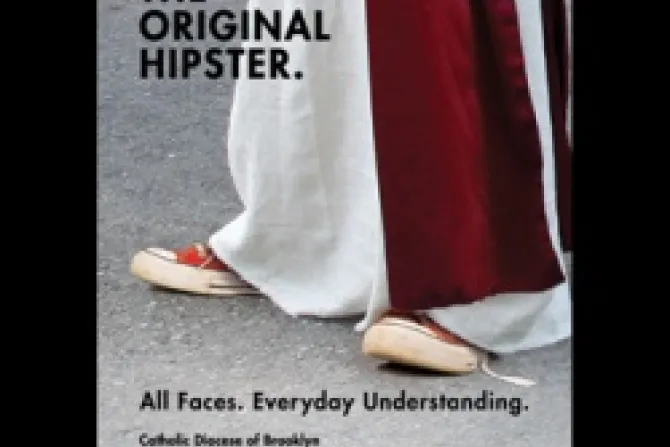Apr 26, 2013 / 03:03 am
A new ad campaign by the Diocese of Brooklyn is hoping to attract the unchurched, with a series of posters calling Christ "The original hipster," as well as ads designed for gyms and bars.
"We're called to go where the people are...to proclaim the gospel of Jesus Christ where people are, be that a bar, gym, restaurant, or what have you," Monsignor Kieran Harrington, vicar for communications at the Brooklyn diocese and campaign creator, told CNA April 24.
"It's not about accommodating Christ to ourselves, but accommodating ourselves to Christ, changing our life; we enter into a deep relationship with Christ and the Church, and our life is changed."
The ad which has garnered the most attention is one which depicts Christ in a robe and Chuck Taylor sneakers, calling him "The original hipster." The bottom of the ad, placed at bus stops and phone booths throughout Brooklyn and Queens, reads "All Faces. Everyday Understanding."
Msgr. Harrington said that though it's acknowledged that Christ was a Semitic man shorter and darker than popular depiction, nevertheless every culture produces its own images of him.
"Religious depictions of Jesus generally represent the people of a particular given day. People in northern Europe and other places often show him having blonde hair and blue eyes. Other places, in Asia, Africa, Latin America, you might see a different depiction of Jesus."
"Well in Brooklyn, there's a lot of young bohemian type folks, and this representation is to enable them to see that we're all called to be another Christ in the world by virtue of our baptism."
The "hipster" depiction of Christ is meant to appeal to the broad demographic of vaguely counter-cultural, Pabst Blue Ribbon-swilling 20-somethings who are more likely to be agnostic or "spiritual but not religious" than regular Mass-goers.
"The point of the Church is precisely that we shouldn't think that just because of how someone dresses, if they wear Converse sneakers, that they can't come to church on Sunday or won't find understanding in church on Sunday," said Msgr. Harrington.
"We've got to think of ways to provoke a conversation, because a lot of people come to us with pre-conceived notions about what people who are religious are like, in the same way that a lot of religious people have pre-conceived notions about other people."
Rather than the Church "accommodating to a different way of life," the monsignor said the ads are an effort to enter into dialogue with those whom it doesn't often encounter. "That's what Jesus did; he entered into dialogue with the woman caught in adultery, and with the woman at the well."
An additional ad posted by the Brooklyn diocese features a photo of a treadmill and is placed in gyms with the caption: "Tired of running in place? Attend Mass."
Another one placed in bars and restaurants shows a man "who's clearly been partying too long," as Msgr. Harrington said, that asks, "Should I get a new habit?"
"There's a lot of noise in Brooklyn, lots of people competing for attention," he said. "You have to cut through the noise, and this ad campaign was meant to do that."
The "All Faces" campaign is meant to reach out to the diverse cultural make-up of Brooklyn and Queens. It runs in Spanish and Chinese as well as English, and links to a parish locator on the diocese's website.
"Whether you're from Guatemala or China or Tennessee, and living in Brooklyn and Queens, all people are welcome at church and we understand where you're coming from," Msgr. Harrington said.
The ads note that the diocese has over 230 churches in the two boroughs. In a diocese of only 179 square miles, that should serve to remind people that they're never far from a Catholic parish.
"It's prompting people to hopefully go back to Mass," reflected Msgr. Harrington.
"When they go to church they'll have the opportunity to hear the gospel message, which is very outward focused, in terms of how the encounter with Christ radically transforms the way I live."



